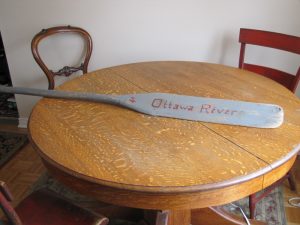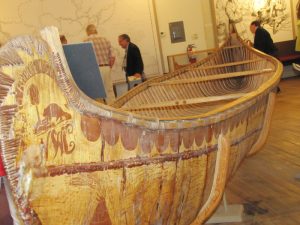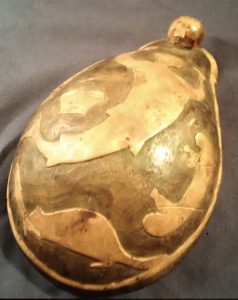By Shaun Markey –
I found it hanging on a wall in a small, local antique shop. It is a crudely made wooden canoe paddle that obviously served someone well over the years.
The owner thought enough of the paddle to paint the words Ottawa River on the blade and the date, presumably the year, “49”, at the base of the handle. I suspect it was made for use in a wooden canoe, which at the time would have been seen all along the Ottawa River. Another paddle I bought from a home in McKellar Park was likely made in the late 1800’s and the blade displays an oil painting of a campsite along the river.
Imagine the stories these paddles could tell! Like the vast majority of antiques, however, they will keep their secrets and leave us to wonder about the makers and the many adventurous trips for which these paddles must have been used on the Ottawa River and nearby tributaries.
As local residents well know, the Ottawa River forms much of the northern boundary of several Kitchissippi communities. For that matter, the river defines the northern boundary of much of Ottawa.
Centuries ago, the Ottawa was the major transportation route to the upper Great Lakes and beyond. This is the waterway that underpinned the life of indigenous people dating back thousands of years and which also supported Europe’s insatiable quest for beaver pelts in the 17thand 18thcentury, as championed by the Hudson Bay Company founded in 1621 and in 1779 by the North West Company. (The two competitors merged in 1821.) It was the humble birch bark canoe that provided the means to reach the fur-bearing regions of Canada and to transport the product back to Montreal and other points in East for shipment overseas.
Indigenous people had long been plying the waters of the Ottawa and its many tributaries in dug out and birch bark canoes. The lightweight birch bark canoe was perfect for Canadian rivers and lakes. It was waterproof, durable and could be repaired, if needed, right on the spot.
Early fur traders of the North West Company recognized the importance of the birch bark canoe and adopted it for their needs including the construction techniques used by indigenous makers. The traders not only adopted the design but also expanded on it, developing huge freighter canoes, the canot du maître, up to 40 feet long, capable of transporting six to twelve men and 5,000 pounds of cargo. What a sight it must have been to see one of these behemoths being paddled down the Ottawa!
[Click images to enlarge]
Beyond Lake Superior, traders used the smaller more versatile canot du nord, which was half the length and width and could transport half the amount of cargo. The fur traders used birch bark canoes until airplanes came on the scene after 1920.
Today, antique dealers and pickers occasionally come across a vintage birch bark canoe tucked away in a barn or outbuilding in the Ottawa Valley. It is always an exciting find as early birch bark canoes can be worth thousands of dollars depending on their condition.
I well remember coming across a child-size bark canoe, about six feet in length, tucked up in the rafters of a building just west of Ottawa. As is often the case though, finding an antique is one thing – buying it is another! Try as I might I could not purchase the canoe from the owners and as far as I know, the little beauty is still resting in the rafters of that old frame cottage.
Accessories, like early paddles, “crooked” knives (used in canoe construction) and canoe cups (carried by paddlers to dip into the water) are also popular. In particular, collectors search out cups and knives that are carved and decorated with animal forms.
The first commercial wood canoe building shop was started by Thomas Gordon of Lakefield, ON in 1858. Wood and wood canvas canoes accounted for the decline of the birch bark variety. The cedar and basswood used in their construction was plentiful in many parts of central and eastern Canada and there were many individuals experienced wood workers in these areas that turned their skills to making wood canoes.
The Peterborough/Lakefield region would go on to become a hot bed of wood canoe manufacturing. Undoubtedly many of the canoes produced by companies like the Peterborough Canoe Company, the Canadian Canoe Company and the Lakefield Canoe and Manufacturing Company would have found their way to Ottawa for use by customers on the many rivers lakes and rivers in this area.
By the late 1800’s, canoeing had become a popular recreational pastime in North America. There were dozens of manufacturers in Canada and the U.S. fabricating wood and wood canvas canoes in a range of sizes and shapes. They added features that would allow one to sail their canoe. Another popular modification, a flat stern, enabled the canoe to be motorized. (I saw one model in a garage near the Civic Hospital that featured a small wind up record player in a space under the front deck!)
Canoe clubs and regattas were popular in many locations and likely would have included groups in locations along the Ottawa River.
Ottawa had at least one canoe manufacturer: Dey Brothers, located near the Laurier Street Bridge that was active from about 1890 to 1920.
Just as birch bark material was replaced by wood and canvas, these materials themselves have since given way to aluminum, fiberglass, Kevlar and other modern synthetics used in canoe fabrication.
Today, canoes and canoeing continue to be a popular with Kitchissippi residents. The canoe, particularly the birch-bark variety, has become an icon and probably is more representative of Canada than any other symbol. This humble yet critical invention supported and enhanced the indigenous civilization of North America and beyond.
The birch bark canoe played a vital role in the early development of Canada and, in its modified forms, continues to serve the recreational needs of Canadians to this day. Most importantly, the river on which an important part of this historic saga took place still flows majestically at Kitchissippi’s doorstep, always there for new generations of paddlers to enjoy.
Shaun Markey is a resident of Westboro and author of a memoir called Folk Art in the Attic. He also blogs about antiques and folk art at folkartintheattic.blogspot.ca.



